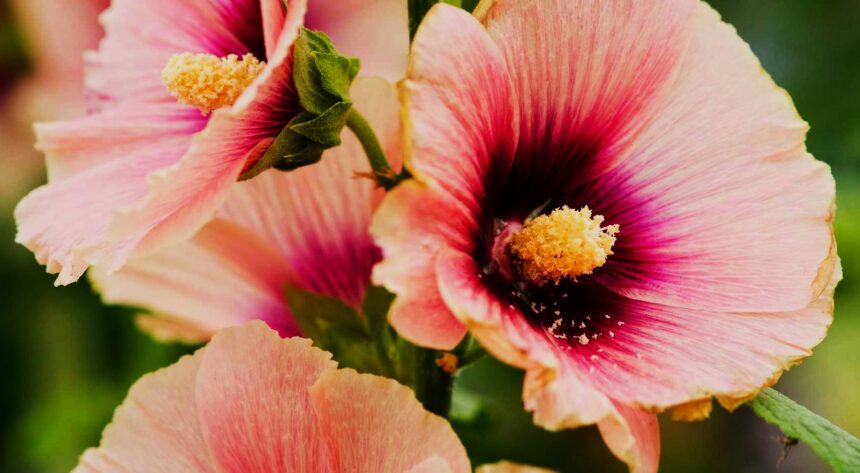Hollyhock, with their majestic spires of colorful blooms, have graced gardens for centuries. Known for their vibrant flowers and towering height, these perennial favorites add a touch of cottage garden charm to any landscape. This comprehensive guide delves into the world of hollyhocks, offering insights into their cultivation, care, and the various varieties that gardeners can choose from.
Introduction to Hollyhock
Hollyhock (Alcea rosea) are herbaceous biennials or short-lived perennials that belong to the Malvaceae family. Originating from Asia and Europe, they have become a staple in gardens worldwide due to their striking appearance and ease of growth. Standing tall at heights of up to 8 feet, holly hocks are perfect for creating vertical interest in flower beds and borders.
The History and Symbolism of Hollyhock
Holly hocks have a rich history dating back to ancient times. They were cultivated in medieval monastery gardens and later became popular in Victorian-era gardens. Symbolically, hollyhocks represent ambition and the desire to reach great heights, reflecting their tall stature. In some cultures, they are also associated with fertility and abundance.
Cultivating Hollyhock
Choosing the Right Location
Holly hocks thrive in full sun, requiring at least 6 hours of direct sunlight daily. While they can tolerate partial shade, the intensity and duration of flowering may be reduced. Choose a location with well-draining soil and ample space for these tall plants to grow without crowding.
Soil Preparation
Holly hocks prefer rich, loamy soil with a pH level between 6.0 and 7.5. Before planting, amend the soil with organic matter such as compost or well-rotted manure to enhance fertility and drainage. Soil preparation is crucial for robust growth and abundant flowering.
Planting Hollyhocks
Holly hocks can be started from seeds, transplants, or nursery plants. Sow seeds directly in the garden in late spring or early summer, spacing them about 2 feet apart to allow for adequate air circulation. Cover the seeds lightly with soil and keep the area moist until germination, which typically occurs within 10-14 days.
Watering and Fertilization
Water holly hocks regularly, especially during dry spells. Ensure the soil is kept consistently moist but not waterlogged. Applying a balanced fertilizer in early spring and mid-summer can promote vigorous growth and prolific blooming.
Caring for Hollyhocks
Staking and Support
Due to their height, holly hocks often require staking to prevent them from toppling over in strong winds. Use garden stakes or bamboo canes and tie the plants gently to provide support. Regularly check and adjust ties to avoid constricting the stems.
Pruning and Deadheading
To encourage continuous blooming, deadhead spent flowers regularly. Cut back the flower stalks to a leaf node to stimulate new growth. At the end of the growing season, cut the plants down to ground level and remove any debris to prevent overwintering pests and diseases.
Pest and Disease Management
Holly hocks are susceptible to rust, a fungal disease that appears as orange spots on the leaves. To manage rust, ensure good air circulation, avoid overhead watering, and apply fungicides if necessary. Common pests include aphids, caterpillars, and spider mites, which can be controlled with insecticidal soap or neem oil.
Popular Varieties of Hollyhock
Single-Flowered Hollyhocks
Single-flowered holly hocks feature a single row of petals around a central stamen, creating a simple yet elegant look. Popular varieties include ‘Blacknight,’ with its deep maroon blooms, and ‘Happy Lights,’ which offers a mix of vibrant colors.
Double-Flowered Hollyhocks
Double-flowered holly hocks boast multiple layers of petals, giving them a fuller, more luxurious appearance. Notable varieties include ‘Chater’s Double,’ available in shades of pink, red, and yellow, and ‘Peaches ‘n Dreams,’ known for its soft peach-colored flowers.
Dwarf Hollyhocks
For gardeners with limited space, dwarf holly hocks provide the same beauty on a smaller scale. Varieties like ‘Queeny Purple’ and ‘Majorette Mix’ grow to a more manageable height of 2-3 feet, making them ideal for small gardens and containers.
Growing Hollyhocks in Containers
While holly hocks are typically grown in garden beds, they can also thrive in containers. Choose a large pot with good drainage and fill it with a high-quality potting mix. Regular watering and fertilization are key to successful container gardening. Dwarf varieties are particularly well-suited for this purpose.
Companion Planting with Hollyhock
Holly hocks pair beautifully with other cottage garden staples such as delphiniums, foxgloves, and roses. Their tall stature makes them excellent backdrop plants, creating a stunning contrast with lower-growing perennials and annuals. Companion planting can also help deter pests and enhance the overall health of the garden.
Harvesting and Using Hollyhock
Holly hocks are not only ornamental but also have practical uses. The flowers can be harvested and used in herbal remedies and natural dyes. Additionally, their dried seed pods add a unique touch to floral arrangements.
Conclusion
Holly hocks are a versatile and charming addition to any garden. With their towering blooms and wide range of colors, they create a stunning visual impact. By following proper cultivation and care practices, gardeners can enjoy these beautiful plants year after year. Whether you are a seasoned gardener or a beginner, holly hocks offer a rewarding gardening experience that brings both beauty and historical significance to your outdoor space.



